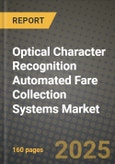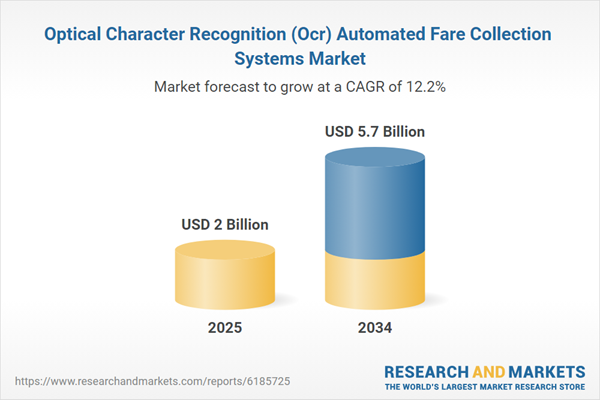The Optical Character Recognition (OCR) automated fare collection systems market is experiencing rapid growth, driven by the increasing demand for seamless, contactless, and intelligent public transportation payment solutions. OCR-based fare collection systems utilize advanced image processing and machine learning algorithms to scan, read, and verify printed and digital tickets, allowing passengers to pay using paper tickets, QR codes, e-tickets, and mobile apps. These systems enhance operational efficiency by reducing reliance on traditional ticketing methods, minimizing fraud, and streamlining passenger flow. Public transit agencies and private transport operators are integrating OCR-based automated fare collection (AFC) systems into buses, trains, metro networks, and toll stations to improve convenience, reduce congestion, and offer a more secure and efficient payment experience. With urbanization accelerating and digital transformation reshaping the transportation sector, governments and transit authorities are investing heavily in smart fare collection infrastructure to improve public mobility and align with smart city initiatives.
The OCR automated fare collection systems market witnessed significant advancements, particularly in AI-powered OCR accuracy, multi-modal integration, and contactless payment expansion. AI-enhanced OCR solutions improved real-time ticket verification accuracy, reducing errors in fare processing and increasing passenger throughput. Transit agencies adopted hybrid fare collection models that combined OCR-based ticket validation with Near Field Communication (NFC) and biometric authentication, enabling a seamless travel experience. The growing adoption of mobile-based QR code ticketing, particularly in emerging economies, contributed to the expansion of OCR-enabled AFC solutions. Additionally, cloud-based fare collection platforms gained popularity, allowing real-time data processing and remote system management for transit authorities. Governments worldwide focused on enhancing public transportation accessibility, leading to increased investments in AI-powered fare collection and digital ticketing infrastructure. With cybersecurity concerns rising, AFC providers also incorporated enhanced encryption and fraud prevention measures, ensuring secure fare transactions while maintaining data privacy for commuters.
The OCR automated fare collection systems market is expected to evolve with innovations in edge AI processing, blockchain-based fare payment systems, and enhanced interoperability between different transport modes. Edge AI will enable real-time OCR processing directly on fare validation devices, reducing latency and improving ticket verification speed. Blockchain technology is set to transform fare collection by providing decentralized, tamper-proof transaction records, ensuring transparency and security in fare payments. The push for integrated mobility solutions will drive the development of unified ticketing systems that allow passengers to use a single payment method across multiple modes of transportation, including buses, trains, ride-sharing services, and micro-mobility options. Additionally, as AI-powered facial recognition and voice-based authentication technologies become more sophisticated, their integration into AFC systems will further enhance passenger convenience and security. Sustainability will also play a key role, with transit agencies adopting eco-friendly ticketing solutions, such as digital receipts and paperless fare processing, to minimize environmental impact.
Key Insights: Optical Character Recognition (Ocr) Automated Fare Collection Systems Market
AI-Powered Real-Time Ticket Verification: AI-driven OCR technology is revolutionizing fare collection by enhancing ticket recognition accuracy and processing speed. Advanced machine learning models enable AFC systems to read and verify printed and digital tickets in real time, reducing fraud and operational errors. AI-powered systems continuously learn and adapt to new ticket formats, improving their ability to handle diverse fare media across transit networks. These innovations are particularly beneficial in high-traffic urban transport systems, where quick and accurate ticket verification enhances passenger flow and reduces boarding delays.Integration of Contactless and Mobile Ticketing Solutions: The growing demand for contactless travel experiences is driving the integration of mobile ticketing and digital wallets with OCR-based AFC systems. Passengers increasingly prefer QR code-based mobile tickets, allowing seamless and secure fare payments via smartphones. Transit agencies are deploying hybrid systems that combine OCR ticket scanning with NFC-enabled smart cards, enhancing payment flexibility. As smartphone penetration rises, mobile-based AFC solutions are expected to dominate, reducing dependency on paper tickets and physical fare collection infrastructure.
Increasing Adoption of Smart City and Digital Transportation Initiatives: Governments worldwide are investing in smart city projects to modernize public transportation infrastructure, fueling demand for automated fare collection solutions. OCR-based AFC systems align with digital transformation goals by improving fare transaction efficiency, reducing manual processing, and enhancing commuter experience. As cities prioritize sustainable and intelligent mobility solutions, investments in AI-powered AFC technology will continue to grow, integrating real-time data analytics and automation into transit operations.
Rising Demand for Fraud Prevention and Secure Fare Transactions: Transit agencies are increasingly focusing on fraud prevention and revenue protection by deploying secure, AI-driven AFC systems. OCR-based fare collection technology minimizes ticket fraud by accurately verifying ticket authenticity, reducing instances of fare evasion. Enhanced security features, such as blockchain-based ticketing and encrypted QR codes, are gaining traction, ensuring that fare transactions remain tamper-proof and transparent. These advancements are driving the adoption of OCR-powered AFC solutions, improving financial sustainability for transit authorities.
Interoperability and Standardization Issues: One of the primary challenges in the OCR automated fare collection market is the lack of universal standards across different transit networks and regions. Variations in ticket formats, fare structures, and legacy systems create integration challenges for AFC providers. Ensuring seamless interoperability between different transportation systems requires collaborative efforts among governments, transit operators, and technology providers, leading to higher implementation costs and complex system upgrades.
Optical Character Recognition (Ocr) Automated Fare Collection Systems Market Segmentation
By Type
- Ticket Vending Machine (TVM)
- Gate (Entry Or Exit Ticket Machines)
- Europay
- Mastercard
- and Visa
- Other Types
By Component
- Hardware
- Software
- Services
By Technology
- Smart Card
- Near Field Communication (NFC)
- Barcode
- Other Technologies
By Application
- Bus
- Train
- Metro
- Other Applications
Key Companies Analysed
- Thales Group
- Ticketer Limited
- Infineon Technologies AG
- Indra Sistemas S.A.
- Hitachi Rail Limited
- Conduent Transportation LLC
- Gemalto N.V.
- Advantech Co. Ltd.
- Cubic Transportation Systems Inc.
- Cubic Corporation +
- GFI Genfare (SPX Corporation)
- Siemens Mobility GmbH
- Flowbird Group SAS
- Scheidt & Bachmann GmbH
- IVU Traffic Technologies AG
- LECIP Holdings Corporation
- Trapeze Group
- INIT GmbH
- Masabi Ltd.
- Farelogix Inc.
- Avail Technologies Inc
Optical Character Recognition (Ocr) Automated Fare Collection Systems Market Analytics
The report employs rigorous tools, including Porter’s Five Forces, value chain mapping, and scenario-based modeling, to assess supply-demand dynamics. Cross-sector influences from parent, derived, and substitute markets are evaluated to identify risks and opportunities. Trade and pricing analytics provide an up-to-date view of international flows, including leading exporters, importers, and regional price trends.Macroeconomic indicators, policy frameworks such as carbon pricing and energy security strategies, and evolving consumer behavior are considered in forecasting scenarios. Recent deal flows, partnerships, and technology innovations are incorporated to assess their impact on future market performance.
Optical Character Recognition (Ocr) Automated Fare Collection Systems Market Competitive Intelligence
The competitive landscape is mapped through proprietary frameworks, profiling leading companies with details on business models, product portfolios, financial performance, and strategic initiatives. Key developments such as mergers & acquisitions, technology collaborations, investment inflows, and regional expansions are analyzed for their competitive impact. The report also identifies emerging players and innovative startups contributing to market disruption.Regional insights highlight the most promising investment destinations, regulatory landscapes, and evolving partnerships across energy and industrial corridors.
Countries Covered
- North America - Optical Character Recognition (Ocr) Automated Fare Collection Systems market data and outlook to 2034
- United States
- Canada
- Mexico
- Europe - Optical Character Recognition (Ocr) Automated Fare Collection Systems market data and outlook to 2034
- Germany
- United Kingdom
- France
- Italy
- Spain
- BeNeLux
- Russia
- Sweden
- Asia-Pacific - Optical Character Recognition (Ocr) Automated Fare Collection Systems market data and outlook to 2034
- China
- Japan
- India
- South Korea
- Australia
- Indonesia
- Malaysia
- Vietnam
- Middle East and Africa - Optical Character Recognition (Ocr) Automated Fare Collection Systems market data and outlook to 2034
- Saudi Arabia
- South Africa
- Iran
- UAE
- Egypt
- South and Central America - Optical Character Recognition (Ocr) Automated Fare Collection Systems market data and outlook to 2034
- Brazil
- Argentina
- Chile
- Peru
Research Methodology
This study combines primary inputs from industry experts across the Optical Character Recognition (Ocr) Automated Fare Collection Systems value chain with secondary data from associations, government publications, trade databases, and company disclosures. Proprietary modeling techniques, including data triangulation, statistical correlation, and scenario planning, are applied to deliver reliable market sizing and forecasting.Key Questions Addressed
- What is the current and forecast market size of the Optical Character Recognition (Ocr) Automated Fare Collection Systems industry at global, regional, and country levels?
- Which types, applications, and technologies present the highest growth potential?
- How are supply chains adapting to geopolitical and economic shocks?
- What role do policy frameworks, trade flows, and sustainability targets play in shaping demand?
- Who are the leading players, and how are their strategies evolving in the face of global uncertainty?
- Which regional “hotspots” and customer segments will outpace the market, and what go-to-market and partnership models best support entry and expansion?
- Where are the most investable opportunities - across technology roadmaps, sustainability-linked innovation, and M&A - and what is the best segment to invest over the next 3-5 years?
Your Key Takeaways from the Optical Character Recognition (Ocr) Automated Fare Collection Systems Market Report
- Global Optical Character Recognition (Ocr) Automated Fare Collection Systems market size and growth projections (CAGR), 2024-2034
- Impact of Russia-Ukraine, Israel-Palestine, and Hamas conflicts on Optical Character Recognition (Ocr) Automated Fare Collection Systems trade, costs, and supply chains
- Optical Character Recognition (Ocr) Automated Fare Collection Systems market size, share, and outlook across 5 regions and 27 countries, 2023-2034
- Optical Character Recognition (Ocr) Automated Fare Collection Systems market size, CAGR, and market share of key products, applications, and end-user verticals, 2023-2034
- Short- and long-term Optical Character Recognition (Ocr) Automated Fare Collection Systems market trends, drivers, restraints, and opportunities
- Porter’s Five Forces analysis, technological developments, and Optical Character Recognition (Ocr) Automated Fare Collection Systems supply chain analysis
- Optical Character Recognition (Ocr) Automated Fare Collection Systems trade analysis, Optical Character Recognition (Ocr) Automated Fare Collection Systems market price analysis, and Optical Character Recognition (Ocr) Automated Fare Collection Systems supply/demand dynamics
- Profiles of 5 leading companies - overview, key strategies, financials, and products
- Latest Optical Character Recognition (Ocr) Automated Fare Collection Systems market news and developments
Additional Support
With the purchase of this report, you will receive:- An updated PDF report and an MS Excel data workbook containing all market tables and figures for easy analysis.
- 7-day post-sale analyst support for clarifications and in-scope supplementary data, ensuring the deliverable aligns precisely with your requirements.
- Complimentary report update to incorporate the latest available data and the impact of recent market developments.
This product will be delivered within 1-3 business days.
Table of Contents
Companies Mentioned
- Thales Group
- Ticketer Limited
- Infineon Technologies AG
- Indra Sistemas S.A.
- Hitachi Rail Limited
- Conduent Transportation LLC
- Gemalto N.V.
- Advantech Co. Ltd.
- Cubic Transportation Systems Inc.
- Cubic Corporation +
- GFI Genfare (SPX Corporation)
- Siemens Mobility GmbH
- Flowbird Group SAS
- Scheidt & Bachmann GmbH
- IVU Traffic Technologies AG
- LECIP Holdings Corporation
- Trapeze Group
- INIT GmbH
- Masabi Ltd.
- Farelogix Inc.
- Avail Technologies Inc.
Table Information
| Report Attribute | Details |
|---|---|
| No. of Pages | 160 |
| Published | October 2025 |
| Forecast Period | 2025 - 2034 |
| Estimated Market Value ( USD | $ 2 Billion |
| Forecasted Market Value ( USD | $ 5.7 Billion |
| Compound Annual Growth Rate | 12.2% |
| Regions Covered | Global |
| No. of Companies Mentioned | 21 |









